Biology:List of C4 plants

In botany, C4 carbon fixation is one of three known methods of photosynthesis used by plants. C4 plants increase their photosynthetic efficiency by reducing or suppressing photorespiration, which mainly occurs under low atmospheric CO
2 concentration, high light, high temperature, drought, and salinity.[2][3] There are roughly 8,100 known C4 species, which belong to at least 61 distinct evolutionary lineages in 19 families (as per APG IV classification[4]) of flowering plants.[1] Among these are important crops such as maize, sorghum and sugarcane, but also weeds and invasive plants.[1] Although only 3% of flowering plant species use C4 carbon fixation, they account for 23% of global primary production.[5] The repeated, convergent C4 evolution from C3 ancestors has spurred hopes to bio-engineer the C4 pathway into C3 crops such as rice.[1][5]
C4 photosynthesis probably first evolved 30–35 million years ago in the Oligocene, and further origins occurred since, most of them in the last 15 million years. C4 plants are mainly found in tropical and warm-temperate regions, predominantly in open grasslands where they are often dominant. While most are graminoids, other growth forms such as forbs, vines, shrubs, and even some trees and aquatic plants are also known among C4 plants.[1]
C4 plants are usually identified by their higher 13C/12C isotopic ratio compared to C3 plants or their typical leaf anatomy.[5] The distribution of C4 lineages among plants has been determined through phylogenetics and was considered well known (As of 2016). Monocots – mainly grasses (Poaceae) and sedges (Cyperaceae) – account for around 80% of C4 species, but they are also found in the eudicots.[1]
The following list presents known C4 lineages by family, based on the overview by Sage (2016).[1] They correspond to single species or clades thought to have acquired the C4 pathway independently. In some lineages that also include C3 and C3–C4 intermediate species, the C4 pathway may have evolved more than once.[1]


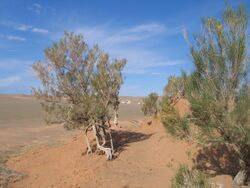
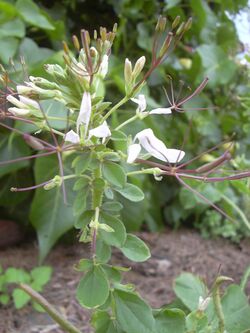
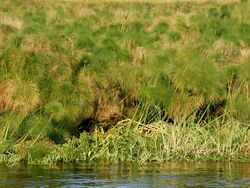

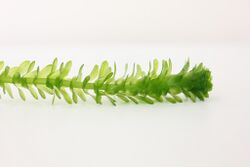
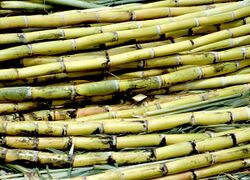
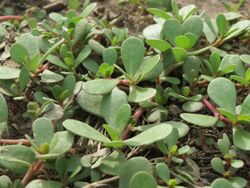
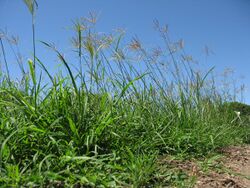

Acanthaceae
The large acanthus family Acanthaceae includes one genus with C4 species, found in dry habitats from Africa to Asia.[8]
- Blepharis – 15 C4 species, 1–4 origins
Aizoaceae
While many species in the ice plant family Aizoaceae use crassulacean acid metabolism (CAM), one subfamily with drought-tolerant and halophytic plants includes C4 species:[9]
- Sesuvioideae – 30 C4 species, 1–6 origins
Amaranthaceae
The amaranth family Amaranthaceae (including the former goosefoot family Chenopodiaceae) contains around 800 known C4 species, which belong to 14 distinct lineages in seven subfamilies. This makes Amaranthaceae the family with most C4 species and lineages among the eudicots.[1] Suaeda aralocaspica and species of the genus Bienertia use a particular, single-cell type of C4 carbon fixation.[1][10]
- Aerva (Amaranthoideae) – 4 C4 species[11]
- Alternanthera (Gomphrenoideae) – 17 C4 species (also includes C3–C4 intermediates)[11]
- Amaranthus (Amaranthoideae) – 90 C4 species[11]
- Atriplex (Chenopodioideae) – around 180 C4 species[12]
- Bassia–Camphorosma clade (Camphorosmoideae) – 24 C4 species (also includes one C3–C4 intermediate), 1–2 origins[13]
- Bienertia (Suaedoideae) – 3 C4 species[10][14]
- Caroxyleae (syn. Caroxyloneae, Salsoloideae) – 157 C4 species[15][16]
- Gomphrenoids (Gomphrenoideae) – 138 C4 species[11]
- Salsoleae (Salsoloideae) – 158 C4 species, 2–4 origins[15][16]
- Suaeda aralocaspica (Suaedoideae)[10]
- Suaeda sect. Salsina – 30 C4 species[10]
- Suaeda sect. Schoberia – 9 C4 species[10]
- Tecticornia – (Salicornioideae) 2 C4 species[17]
- Tidestromia (Gomphrenoideae) – 8 C4 species[11]
Asteraceae
The composite family Asteraceae contains three C4 lineages, in two different tribes of subfamily Asteroideae.[1][18] They include the model genus Flaveria with closely related C3, C4, and intermediate species.[1]
- Flaveria (Tageteae) – 7 C4 species, 2–3 origins (also includes C3 and intermediate)[1][19][20]
- Coreopsideae – 41 C4 species[18]
- Pectis (Tageteae) – 90 C4 species[21]
Boraginaceae
The borage family Boraginaceae contains one widespread C4 genus, Euploca, which has also been treated as part of a distinct family Heliotropiaceae.[22]
Cleomaceae
The Cleomaceae, formerly included in the caper family Capparaceae, contains three C4 species in genus Cleome. These three species independently acquired the C4 pathway; the genus also contains numerous C3 as well as C3–C4 intermediate species.[1][24][25]
Caryophyllaceae
In the carnation family Caryophyllaceae, the C4 pathway evolved once, in a clade within the polyphyletic genus Polycarpaea.[1][26]
- Polycarpaea – 20 C4 species
Cyperaceae
The sedge family Cyperaceae is second only to the grasses in number of C4 species. Prominent C4 sedges include culturally important species such as papyrus (Cyperus papyrus) and chufa (C. esculentus) but also purple nutsedge (C. rotundus), one of the world's major weeds. Eleocharis vivipara uses C3 carbon fixation in underwater leaves and C4 carbon fixation in aerial leaves.[1]
- Bulbostylis – 211 C4 species
- Cyperus – 757 C4 species
- Eleocharis ser. Tenuissimae – 10 C4 species
- Eleocharis vivipara
- Fimbristylis – 303 C4 species
- Rhynchospora – 40 C4 species
Euphorbiaceae
The spurge family Euphorbiaceae contains the largest single C4 lineage among eudicots. The C4 spurges are diverse and widespread; they range from weedy herbs to the only known C4 trees – four species from Hawaii, including Euphorbia olowaluana (up to 10 m) and E. herbstii (up to 8 m).[1][6]
- Euphorbia subgenus Chamaesyce section Anisophyllum (also treated as genus Chamaesyce) – 350 C4 species (also including C3 and C3–C4 intermediate species)
Gisekiaceae
Contains a C4 genus with a single species.
- Gisekia pharnaceoides[27]
Hydrocharitaceae
Includes the only known aquatic C4 plants.[1]
- Egeria densa
- Hydrilla verticillata
Molluginaceae
The two C4 species within the same genus have acquired the pathway independently.
- Mollugo – 2 C4 species, 2 origins
Nyctaginaceae
Polygonaceae
- Calligonum – 80 C4 species
Portulacaceae
The single genus of this family forms one C4 lineage. CAM photosynthesis is also known. Common purslane (Portulaca oleracea) is a major weed but also a vegetable.[1]
- Portulaca – 100 C4 species, 1–2 origins
Poaceae
The grass family includes most of the known C4 species – around 5000. They are only found in subfamilies of the PACMAD clade. Major C4 crops such as maize, sugarcane, sorghum and pearl millet belong in this family. The only known species with C3, C4 and intermediate variants, Alloteropsis semialata, is a grass.[1]
- Aristida – 288 C4 species
- Stipagrostis – 56 C4 species
- Chloridoideae (without Centropodieae) – 1596 C4 species
- Centropodia – 4 C4 species
- Eriachne – 50 C4 species
- Tristachyideae – 87 C4 species
- Andropogoneae – 1228 C4 species (incl. maize, sugarcane, sorghum)
- Reynaudia filiformis
- Axonopus – 90 C4 species
- Paspalum – 379 C4 species
- Anthaenantia – 4 C4 species
- Arthropoginae/Mesosetum clade – 35 C4 species, 1–2 origins
- Arthropoginae/Onchorachis clade – 2 C4 species
- Arthropoginae/Colaeteania clade – 7 C4 species, 1–2 origins
- Anthephorinae – 286 C4 species
- Echinochloa – 35 C4 species
- Neurachne–Paraneurachne – 2 C4 species, 2 origins
- Melinidinae–Panicinae–Cenchrinae – 889 C4 species
- Alloteropsis – 5 C4 species, 1–2 origins (incl. C3 and intermediate)
Scrophulariaceae
- Anticharis – 4 C4 species
Zygophyllaceae
- Tribuloideae – 37 C4 species, 1–2 origins
- Tetraena simplex
References
- ↑ 1.00 1.01 1.02 1.03 1.04 1.05 1.06 1.07 1.08 1.09 1.10 1.11 1.12 1.13 1.14 1.15 1.16 1.17 1.18 1.19 1.20 1.21 1.22 1.23 1.24 1.25 1.26 1.27 1.28 Sage, R.F. (2016). "A portrait of the C4 photosynthetic family on the 50th anniversary of its discovery: species number, evolutionary lineages, and Hall of Fame". Journal of Experimental Botany 67 (14): 4039–4056. doi:10.1093/jxb/erw156. ISSN 0022-0957. PMID 27053721.

- ↑ Sage, R.F.; Sage, T.L.; Kocacinar, F. (2012). "Photorespiration and the evolution of C4 photosynthesis". Annual Review of Plant Biology 63 (1): 19–47. doi:10.1146/annurev-arplant-042811-105511. ISSN 1543-5008. PMID 22404472. https://www.researchgate.net/publication/221690536.
- ↑ Christin, P.-A.; Osborne, C.P. (2014). "The evolutionary ecology of C4 plants". New Phytologist 204 (4): 765–781. doi:10.1111/nph.13033. ISSN 0028-646X. PMID 25263843. http://eprints.whiterose.ac.uk/95833/1/ChristinOsborne_NewPhytol.pdf.

- ↑ Angiosperm Phylogeny Group (2016). "An update of the Angiosperm Phylogeny Group classification for the orders and families of flowering plants: APG IV". Botanical Journal of the Linnean Society 181 (1): 1–20. doi:10.1111/boj.12385.

- ↑ 5.0 5.1 5.2 Kellogg, E.A. (2013). "C4 photosynthesis". Current Biology 23 (14): R594–R599. doi:10.1016/j.cub.2013.04.066. ISSN 0960-9822. PMID 23885869.

- ↑ 6.0 6.1 Yang, Y.; Berry, P.E. (2011). "Phylogenetics of the Chamaesyce clade (Euphorbia, Euphorbiaceae): Reticulate evolution and long-distance dispersal in a prominent C4 lineage". American Journal of Botany 98 (9): 1486–1503. doi:10.3732/ajb.1000496. ISSN 0002-9122. PMID 21875975. https://deepblue.lib.umich.edu/bitstream/2027.42/142099/1/ajb21486.pdf.

- ↑ Koch, K. E.; Kennedy, R. A. (1982). "Crassulacean acid metabolism in the succulent C4 dicot, Portulaca oleracea L. under natural environmental conditions". Plant Physiology 69 (4): 757–761. doi:10.1104/pp.69.4.757. ISSN 0032-0889. PMID 16662291.

- ↑ Fisher, A.E.; McDade, L.A.; Kiel, C.A. et al. (2015). "Evolutionary history of Blepharis (Acanthaceae) and the origin of C4 photosynthesis in section Acanthodium". International Journal of Plant Sciences 176 (8): 770–790. doi:10.1086/683011. ISSN 1058-5893.

- ↑ Bohley, K.; Joos, O.; Hartmann, H. et al. (2015). "Phylogeny of Sesuvioideae (Aizoaceae) – biogeography, leaf anatomy and the evolution of C4 photosynthesis". Perspectives in Plant Ecology, Evolution and Systematics 17 (2): 116–130. doi:10.1016/j.ppees.2014.12.003. ISSN 1433-8319.
- ↑ 10.0 10.1 10.2 10.3 10.4 Schütze, P.; Freitag, H.; Weising, K. (2003). "An integrated molecular and morphological study of the subfamily Suaedoideae Ulbr. (Chenopodiaceae)". Plant Systematics and Evolution 239 (3–4): 257–286. doi:10.1007/s00606-003-0013-2. ISSN 0378-2697.
- ↑ 11.0 11.1 11.2 11.3 11.4 Sage, R.F.; Sage, T.L.; Pearcy, R.W.; Borsch, T. (2007). "The taxonomic distribution of C4 photosynthesis in Amaranthaceae sensu stricto". American Journal of Botany 94 (12): 1992–2003. doi:10.3732/ajb.94.12.1992. ISSN 0002-9122. PMID 21636394.

- ↑ Kadereit, G.; Mavrodiev, E.V.; Zacharias, E.H.; Sukhorukov, A.P. (2010). "Molecular phylogeny of Atripliceae (Chenopodioideae, Chenopodiaceae): Implications for systematics, biogeography, flower and fruit evolution, and the origin of C4 photosynthesis". American Journal of Botany 97 (10): 1664–1687. doi:10.3732/ajb.1000169. ISSN 0002-9122. PMID 21616801.

- ↑ Kadereit, G.; Freitag, H. (2011). "Molecular phylogeny of Camphorosmeae (Camphorosmoideae, Chenopodiaceae): Implications for biogeography, evolution of C4-photosynthesis and taxonomy". Taxon 60 (1): 51–78. doi:10.1002/tax.601006. https://www.researchgate.net/publication/239463574.
- ↑ Kapralov, M.V.; Akhani, H.; Voznesenskaya, E.V.; Edwards, G.; Franceschi, V.; Roalson, E.H. (2006). "Phylogenetic Relationships in the Salicornioideae / Suaedoideae / Salsoloideae s.l. (Chenopodiaceae) clade and a clarification of the phylogenetic position of Bienertia and Alexandra using multiple DNA sequence datasets". Systematic Botany 31 (3): 571–585. doi:10.1600/036364406778388674. ISSN 0363-6445.
- ↑ 15.0 15.1 Pyankov, V.; Ziegler, H.; Kuz'min, A.; Edwards, G. (2001). "Origin and evolution of C4 photosynthesis in the tribe Salsoleae (Chenopodiaceae) based on anatomical and biochemical types in leaves and cotyledons". Plant Systematics and Evolution 230 (1–2): 43–74. doi:10.1007/s006060170004. ISSN 0378-2697.
- ↑ 16.0 16.1 Akhani, H.; Edwards, G.; Roalson, E.H. (2007). "Diversification of the Old World Salsoleae s.l. (Chenopodiaceae): Molecular phylogenetic analysis of nuclear and chloroplast data sets and a revised classification". International Journal of Plant Sciences 168 (6): 931–956. doi:10.1086/518263. ISSN 1058-5893.
- ↑ Voznesenskaya, E.V.; Akhani, H.; Koteyeva, N.K. et al. (2008). "Structural, biochemical, and physiological characterization of photosynthesis in two C4 subspecies of Tecticornia indica and the C3 species Tecticornia pergranulata (Chenopodiaceae)". Journal of Experimental Botany 59 (7): 1715–1734. doi:10.1093/jxb/ern028. ISSN 1460-2431. PMID 18390850.
- ↑ 18.0 18.1 Kellogg, E.A. (1999). "Phylogenetic aspects of the evolution of C4 photosynthesis". C4 plant biology. San Diego, CA: Academic Press. pp. 411–44. ISBN 978-0126144406. https://www.researchgate.net/profile/Antoine_Souron/post/Is_there_a_checklist_of_plant_taxa_and_their_photosynthetic_pathway/attachment/59d62551c49f478072e9a355/AS:272157525905417@1441898818754/download/Sage+1999.pdf#page=428. Retrieved 2018-05-26.
- ↑ McKown, A.D.; Moncalvo, J.-M.; Dengler, N.G. (2005). "Phylogeny of Flaveria (Asteraceae) and inference of C4 photosynthesis evolution". American Journal of Botany 92 (11): 1911–1928. doi:10.3732/ajb.92.11.1911. ISSN 0002-9122. PMID 21646108.

- ↑ Lyu, M.-J.A.; Gowik, U.; Kelly, S. et al. (2015). "RNA-Seq based phylogeny recapitulates previous phylogeny of the genus Flaveria (Asteraceae) with some modifications". BMC Evolutionary Biology 15 (1): 116. doi:10.1186/s12862-015-0399-9. ISSN 1471-2148. PMID 26084484.

- ↑ Hansen, D.R. (2012). The molecular phylogeny of Pectis L. (Tageteae, Asteraceae), with implications for taxonomy, biogeography, and the evolution of C4 photosynthesis (Doctoral dissertation). University of Texas, Austin. Retrieved 2018-05-27.

- ↑ Luebert, F.; Cecchi, L.; Frohlich, M.W.; Gottschling, M.; Guilliams, C.M.; Hasenstab-Lehman, K.E.; Hilger, H.H.; Miller, J.S. et al. (2016). "Familial classification of the Boraginales". Taxon 65 (3): 502–522. doi:10.12705/653.5. ISSN 0040-0262. https://www.researchgate.net/publication/304454062. Retrieved 16 June 2018.
- ↑ Vogan, P.J.; Frohlich, M.W.; Sage, R.F. (2007). "The functional significance of C3–C4 intermediate traits in Heliotropium L. (Boraginaceae): gas exchange perspectives". Plant, Cell & Environment 30 (10): 1337–1345. doi:10.1111/j.1365-3040.2007.01706.x. ISSN 0140-7791. PMID 17727423.

- ↑ Marshall, D.M.; Muhaidat, R.; Brown, N.J. et al. (2007). "Cleome, a genus closely related to Arabidopsis, contains species spanning a developmental progression from C3 to C4 photosynthesis". The Plant Journal 51 (5): 886–896. doi:10.1111/j.1365-313X.2007.03188.x. ISSN 0960-7412. PMID 17692080.

- ↑ Feodorova, T.A.; Voznesenskaya, E.V.; Edwards, G.E.; Roalson, E.H. (2010). "Biogeographic patterns of diversification and the origins of C4 in Cleome (Cleomaceae)". Systematic Botany 35 (4): 811–826. doi:10.1600/036364410X539880. ISSN 0363-6445. http://msu-botany.ru/gallery/feodorova-5-&2010.pdf. Retrieved 16 June 2016.
- ↑ Kool, A. (2012). Desert plants and deserted islands: systematics and ethnobotany in Caryophyllaceae (PhD thesis). Uppsala University. pp. 35–36. ISBN 978-91-554-8471-2. Retrieved 23 June 2018.

- ↑ Bissinger, K.; Khoshravesh, R.; Kotrade, J.P. et al. (2014). "Gisekia (Gisekiaceae): Phylogenetic relationships, biogeography, and ecophysiology of a poorly known C4 lineage in the Caryophyllales". American Journal of Botany 101 (3): 499–509. doi:10.3732/ajb.1300279. ISSN 0002-9122. PMID 24638165.

 |

